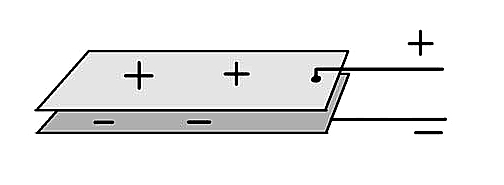Wurlitzer 4600 series
North Suburban Hammond Organ Service
In order to understand how these reeds in the Wurlitzer ES organs can function as generators of alternating current musical signals, we must first look at capacitors and learn a little bit about them. An elementary capacitor is nothing more than a set of two metal plates which are in rather close proximity, but nevertheless do not touch each other. As such, it looks, in diagrammatic form, like this: figure two, below.
If we connect the two plates to a source of direct current as indicated by the two lead-in wires and the plus and minus signs at the right of the picture, a current will flow briefly until both top and bottom plates are charged respectively positive and negative.

Figure 2.Here is a schematic of an elementary capacitor. When a DC voltage is applied to the two lead-in wires, the plates become charged positive and negative as shown by the plus and minus signs. A current will flow until the voltage across the capacitor equals the applied voltage.
Once the plates are charged, no more current flow is possible unless something changes. If we were to disconnect the source of DC voltage, then the plates would retain (theoretically indefinitely) this charge, and a voltage, equal to the original charging voltage would exist across the two plates.
Suppose, however, that we brought the plates closer together. This would increase the capacitance of the device, that is, it could store a bigger charge. Therefore, if we move the plates closer together while this capacitor is connected to the power source, more current will flow from the source until a new balance exists, at which time no more current can flow.
Likewise, if we move the plates farther apart, the capacitance of the device decreases. Doing this lessens the charge, and a current will flow OUT of the capacitor and back to the source until a new balance is achieved, when once again steady state conditions occur.
The value (capacitance) of a capacitor can be increased by either of the following: increasing the area of the plates, or reducing the distance between the plates. In our example here, we selected changing the distance between the plates as the means that we will use to change the capacitor's value. This is, by the way, the easier way to change the capacitor's value.
It's important to realize that when we change the value of a capacitor that is connected to a voltage source, that current will flow into the device when we increase the capacitor's value, and likewise that current will flow out of the capacitor when we decrease its value. Furthermore, in relation to the Wurlitzer electrostatic organ, it's important to see that if we have a capacitor in which one plate constantly moves back and forth, then if we apply a DC charge to the capacitor, a corresponding alternating current will develop as current flows into and then back out of this capacitor with one constantly moving plate. On the next page, we have a simple animated .gif that shows how this happens.
Previous Page Page 2. Next page